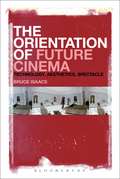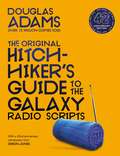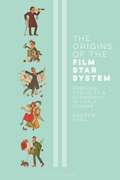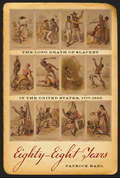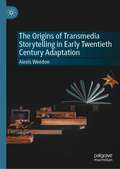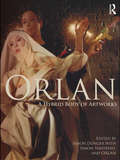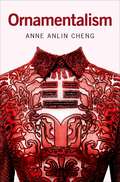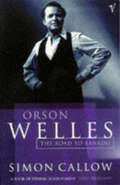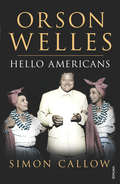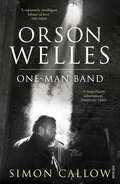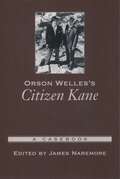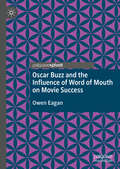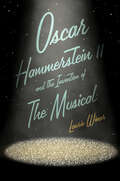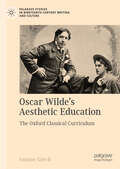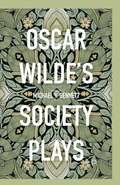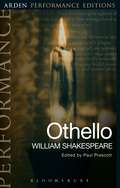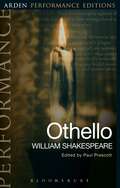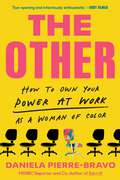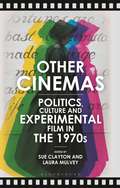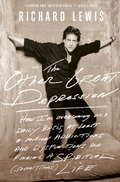- Table View
- List View
Orientalism and Reverse Orientalism in Literature and Film: Beyond East and West (Routledge Interdisciplinary Perspectives on Literature)
by Sharmani Patricia Gabriel Bernard WilsonAcknowledging the significance of Edward Said’s Orientalism for contemporary discourse, the contributors to this volume deconstruct, rearrange, and challenge elements of his thesis, looking at the new conditions and opportunities offered by globalization. What can a renewed or reconceptualized Orientalism teach us about the force and limits of our racial imaginary, specifically in relation to various national contexts? In what ways, for example, considering our greater cross-cultural interaction, have clichés and stereotypes undergone a metamorphosis in contemporary societies and cultures? Theoretically, and empirically, this book offers an expansive range of contexts, comprising the insights, analytical positions, and perspectives of a transnational team of scholars of comparative literature and literary and cultural studies based in Australia, Hong Kong, Japan, Malaysia, USA, Singapore, Taiwan, and Turkey. Working with, through and beyond Orientalism, they examine a variety of cultural texts, including the novel, short story, poetry, film, graphic memoir, social thought, and life writing. Making connections across centuries and continents, they articulate cultural representation and discourse through multiple approaches including critical content analysis, historical contextualization, postcolonial theory, gender theory, performativity, intertextuality, and intersectionality. Given its unique approach, this book will be essential reading for scholars of literary theory, film studies and Asian studies, as well as for those with a general interest in postcolonial literature and film.
Orientalism and Reverse Orientalism in Literature and Film: Beyond East and West (Routledge Interdisciplinary Perspectives on Literature)
by Sharmani Patricia Gabriel Bernard WilsonAcknowledging the significance of Edward Said’s Orientalism for contemporary discourse, the contributors to this volume deconstruct, rearrange, and challenge elements of his thesis, looking at the new conditions and opportunities offered by globalization. What can a renewed or reconceptualized Orientalism teach us about the force and limits of our racial imaginary, specifically in relation to various national contexts? In what ways, for example, considering our greater cross-cultural interaction, have clichés and stereotypes undergone a metamorphosis in contemporary societies and cultures? Theoretically, and empirically, this book offers an expansive range of contexts, comprising the insights, analytical positions, and perspectives of a transnational team of scholars of comparative literature and literary and cultural studies based in Australia, Hong Kong, Japan, Malaysia, USA, Singapore, Taiwan, and Turkey. Working with, through and beyond Orientalism, they examine a variety of cultural texts, including the novel, short story, poetry, film, graphic memoir, social thought, and life writing. Making connections across centuries and continents, they articulate cultural representation and discourse through multiple approaches including critical content analysis, historical contextualization, postcolonial theory, gender theory, performativity, intertextuality, and intersectionality. Given its unique approach, this book will be essential reading for scholars of literary theory, film studies and Asian studies, as well as for those with a general interest in postcolonial literature and film.
The Orientation of Future Cinema: Technology, Aesthetics, Spectacle
by Bruce IsaacsWhat is the fate of cinema in an age of new technologies, new aesthetic styles, new modes of cultural production and consumption? What becomes of cinema and a century-long history of the moving image when the theatre is outmoded as a social and aesthetic space, as celluloid gives over to digital technology, as the art-house and multiplex are overtaken by a proliferation of home entertainment systems? The Orientation of Future Cinema offers an ambitious and compelling argument for the continued life of cinema as image, narrative and experience. Commencing with Lumière's Arrival of a Train at a Station, Bruce Isaacs confronts the threat of contemporary digital technologies and processes by returning to cinema's complex history as a technological and industrial phenomenon. The technology of moving images has profoundly changed; and yet cinema materialises ever more forcefully in digital capture and augmentation, 3-D perception and affect, High Frame Rate cinema, and the evolution of spectacle as the dominant aesthetic mode in contemporary studio production.
The Orientation of Future Cinema: Technology, Aesthetics, Spectacle
by Bruce IsaacsWhat is the fate of cinema in an age of new technologies, new aesthetic styles, new modes of cultural production and consumption? What becomes of cinema and a century-long history of the moving image when the theatre is outmoded as a social and aesthetic space, as celluloid gives over to digital technology, as the art-house and multiplex are overtaken by a proliferation of home entertainment systems? The Orientation of Future Cinema offers an ambitious and compelling argument for the continued life of cinema as image, narrative and experience. Commencing with Lumière's Arrival of a Train at a Station, Bruce Isaacs confronts the threat of contemporary digital technologies and processes by returning to cinema's complex history as a technological and industrial phenomenon. The technology of moving images has profoundly changed; and yet cinema materialises ever more forcefully in digital capture and augmentation, 3-D perception and affect, High Frame Rate cinema, and the evolution of spectacle as the dominant aesthetic mode in contemporary studio production.
The Original Hitchhiker's Guide to the Galaxy Radio Scripts: The Original Radio Scripts
by Douglas AdamsMarch 1978 saw the first ever transmission of Douglas Adams' The Hitchhiker's Guide to the Galaxy on BBC Radio 4; the beginning of a cult phenomenon. March 2020 marks the 42nd anniversary of that first transmission – 42 being the answer, of course, to the Ultimate Question of Life, the Universe, and Everything. To mark the occasion, Pan Macmillan are bringing back into print The Hitchhiker's Guide to the Galaxy: The Original Radio Scripts with a brand-new introduction from Simon Jones.The collection also includes the previously 'lost' Hitchhiker script from the 25th anniversary edition, 'Sheila's Ear' and the original introductions by producer Geoffrey Perkins and Douglas Adams.This collection, which is a faithful reproduction of the text as it was first published in 1985, features all twelve original radio scripts – Hitchhiker as it was written and exactly as it was broadcast for the very first time. They include amendments and additions made during recordings and original notes on the writing and producing of the series by Douglas Adams and Geoffrey Perkins. For those who have always loved Douglas Adams, as well as for his new generation of fans, these scripts are essential reading and a must-have piece of Adams memorabilia.This special anniversary edition will sit alongside reissued eye-catching editions of the five individual Hitchhiker books coming in May 2020: The Hitchhiker's Guide to the Galaxy, The Restaurant at the End of the Universe, Life, the Universe and Everything, So Long, and Thanks for All the Fish and Mostly Harmless.
The Origins of the Film Star System: Persona, Publicity and Economics in Early Cinema (International Library of the Moving Image)
by Andrew ShailFilm stars are central to today's celebrity-obsessed culture. Yet, in the early decades of cinema, the industry faced disincentives to using the identities of performers for publicity. For over 12 years after the invention of the projector, the major production centres of the world made fiction films without the use of constructed star personas. Explaining then the reasons why and how film companies in North America and Europe created 'stars,' in the years 1909-1911, Andrew Shail here responds to Richard deCordova's comprehensive and landmark account, which argued that the development of the Hollywood star system was indebted to precise collaboration between the American press and movie industry. Assembling evidence from a multitude of unused and little-used archives, Shail reveals how this major aspect of show business actually originated in France. Furthermore, Shail reassesses this key period of early cinema history to explore character-based series films. His astute analysis demonstrates how such characters both prefigured and precipitated the star system, that series characters and the 'constellation' of film stars are functionally equivalent and finally argues that openly fictional characters still provide the primary model for 'real' film stars today. Writing with clarity on complex new revelations, this revisionary cultural history is an invaluable addition to the study of stardom at the start of the 20th century and a vital tool to understanding the use of star personas through time.
The Origins of the Film Star System: Persona, Publicity and Economics in Early Cinema (International Library of the Moving Image #52)
by Andrew ShailFilm stars are central to today's celebrity-obsessed culture. Yet, in the early decades of cinema, the industry faced disincentives to using the identities of performers for publicity. For over 12 years after the invention of the projector, the major production centres of the world made fiction films without the use of constructed star personas. Explaining then the reasons why and how film companies in North America and Europe created 'stars,' in the years 1909-1911, Andrew Shail here responds to Richard deCordova's comprehensive and landmark account, which argued that the development of the Hollywood star system was indebted to precise collaboration between the American press and movie industry. Assembling evidence from a multitude of unused and little-used archives, Shail reveals how this major aspect of show business actually originated in France. Furthermore, Shail reassesses this key period of early cinema history to explore character-based series films. His astute analysis demonstrates how such characters both prefigured and precipitated the star system, that series characters and the 'constellation' of film stars are functionally equivalent and finally argues that openly fictional characters still provide the primary model for 'real' film stars today. Writing with clarity on complex new revelations, this revisionary cultural history is an invaluable addition to the study of stardom at the start of the 20th century and a vital tool to understanding the use of star personas through time.
The Origins of Transmedia Storytelling in Early Twentieth Century Adaptation
by Alexis WeedonThis book explores the significance of professional writers and their role in developing British storytelling in the 1920s and 1930s, and their influence on the poetics of today’s transmedia storytelling. Modern techniques can be traced back to the early twentieth century when film, radio and television provided professional writers with new formats and revenue streams for their fiction. The book explores the contribution of four British authors, household names in their day, who adapted work for film, television and radio. Although celebrities between the wars, Clemence Dane, G.B. Stern, Hugh Walpole and A.E.W Mason have fallen from view. The popular playwright Dane, witty novelist Stern and raconteur Walpole have been marginalised for being German, Jewish, female or gay and Mason’s contribution to film has been overlooked also. It argues that these and other vocational authors should be reassessed for their contribution to new media forms of storytelling. The book makes a significant contribution in the fields of media studies, adaptation studies, and the literary middlebrow.
ORLAN: A Hybrid Body of Artworks
by Simon DongerORLAN: A Hybrid Body of Artworks is an in-depth academic account of ORLAN's pioneering art in its entirety. The book covers her career in performance and a range of other art forms. This single accessible overview of ORLAN's practices describes and analyses her various innovative uses of the body as artistic material. Edited by Simon Donger with Simon Shepherd and ORLAN herself, the collection highlights her artistic impact from the perspectives of both performance and visual cultures. The book features: vintage texts by ORLAN and on ORLAN's work, including manifestos, key writings and critical studies ten new contributions, responses and interviews by leading international specialists on performance and visual arts over fifty images demonstrating ORLAN's art, with thirty full colour pictures a new essay by ORLAN, written specially for this volume a new bibliography of writing on ORLAN an indexed listing of ORLAN’s artworks and key themes.
ORLAN: A Hybrid Body of Artworks
by Simon Donger Simon ShepherdORLAN: A Hybrid Body of Artworks is an in-depth academic account of ORLAN's pioneering art in its entirety. The book covers her career in performance and a range of other art forms. This single accessible overview of ORLAN's practices describes and analyses her various innovative uses of the body as artistic material. Edited by Simon Donger with Simon Shepherd and ORLAN herself, the collection highlights her artistic impact from the perspectives of both performance and visual cultures. The book features: vintage texts by ORLAN and on ORLAN's work, including manifestos, key writings and critical studies ten new contributions, responses and interviews by leading international specialists on performance and visual arts over fifty images demonstrating ORLAN's art, with thirty full colour pictures a new essay by ORLAN, written specially for this volume a new bibliography of writing on ORLAN an indexed listing of ORLAN’s artworks and key themes.
Ornamentalism
by Anne Anlin ChengFocusing on the cultural and philosophic conflation between the "oriental" and the "ornamental," Ornamentalism offers an original and sustained theory about Asiatic femininity in western culture. This study pushes our vocabulary about the woman of color past the usual platitudes about objectification and past the critique of Orientalism in order to formulate a fresher and sharper understanding of the representation, circulation, and ontology of Asiatic femininity. This book alters the foundational terms of racialized femininity by allowing us to conceptualize race and gender without being solely beholden to flesh or skin. Tracing a direct link between the making of Asiatic femininity and a technological history of synthetic personhood in the West from the nineteenth to the twenty-first century, Ornamentalism demonstrates how the construction of modern personhood in the multiple realms of law, culture, and art has been surprisingly indebted to this very marginal figure and places Asian femininity at the center of an entire epistemology of race. Drawing from and speaking to the multiple fields of feminism, critical race theory, visual culture, performance studies, legal studies, Modernism, Orientalism, Object Studies and New Materialism, Ornamentalism will leave reader with a greater understanding of what it is to exist as a "person-thing" within the contradictions of American culture.
Orson Welles, Volume 1: The Road to Xanadu
by Simon CallowA brilliant biography of the young Orson Welles, from his prodigious childhood and youth, his triumphs with the Mercury Theatre, to the making of Citizen Kane. Vivid, vastly entertaining, this is the definitive Welles biography.
Orson Welles, Volume 2: Hello Americans
by Simon CallowThe reason for the decline of Orson Welles's career is a hotly debated issue, but decline it certainly did. When Citizen Kane, his first film, opened in 1941, Welles was universally acclaimed as the most audacious filmmaker alive. But instead of marking the beginning of a triumphant career in Hollywood, the film still regularly voted the greatest ever made proved to be an exception in Welles's life and work. In 1947 Welles left America for Europe and lived for the best part of twenty years in self-imposed exile. Welles himself famously quipped 'I started at the top and worked my way down' - the second volume of Simon Callow's compelling biography tells the story of that complex and protracted descent from grace.
Orson Welles, Volume 3: One-Man Band (Orson Welles Biographies #5)
by Simon CallowIn One-Man Band, the third volume in his epic survey of Orson Welles’ life and work, Simon Callow again probes in comprehensive and penetrating detail into one of the most complex artists of the twentieth century, looking closely at the triumphs and failures of an ambitious one-man assault on one medium after another – theatre, radio, film, television, even, at one point, ballet – in each of which his radical and original approach opened up new directions and hitherto unglimpsed possibilities.The book begins with Welles’ self-exile from America, and his realisation that he could only function happily as an independent film-maker, a one-man band; by 1964, he had filmed Othello, which took three years to complete, Mr Arkadin, the biggest conundrum in his output, and his masterpiece Chimes at Midnight, as well as Touch of Evil, his sole return to Hollywood and, like all too many of his films, wrested from his grasp and re-edited. Along the way he made inroads into the fledgling medium of television and a number of stage plays, including Moby-Dick, considered by theatre historians to be one of the seminal productions of the century. Meanwhile, his private life was as dramatic as his professional life. The book shows what it was like to be around Welles, and, with a precision rarely attempted before, what it was like to be him, in which lies the answer to the old riddle: whatever happened to Orson Welles?
Orson Welles's Citizen Kane: A Casebook (Casebooks in Criticism)
Citizen Kane is arguably the most admired and significant film since the advent of talking pictures. No other film is quite so interesting from both artistic and political points of view. To study it even briefly is to learn a great deal about American history, motion-picture style, and the literary aspects of motion-picture scripts. Rather than presenting a sterile display of critical methodologies, James Naremore has gathered a set of essays that represent the essential writings on the film. It gives the reader a lively set of critical interpretations, together with the necessary production information, historical background, and technical understanding to comprehend the film's larger cultural significance. Selections range from the anecdotal --Peter Bogdanovich's interview with Orson Welles--to the critical, with discussions on the scripts and sound track, and a discussion of what accounts for the film's enduring popularity. Contributors include James Naremore, Peter Bogdanovich, Jonathan Rosenbaum, Robert L. Carringer, François Thomas, Michael Denning, Laura Mulvey, Peter Wollen, and Paul Arthur.
Oscar Buzz and the Influence of Word of Mouth on Movie Success
by Owen EaganThis book explores why word of mouth is the most important determinant of a movie’s success. Beginning with a discussion of the enduring appeal of movies, and why the box office has survived the disruption of television and will likely survive the disruption of streaming services, Owen Eagan goes on to discuss the unpredictable nature of movies and ways to mitigate their risk. His astute analysis sheds light on the role of film festivals, film critics, Oscar campaigns, and word of mouth in influencing a film's success. Eagan concludes with a summary of why word of mouth is the most influential among all the variables that affect a film’s outcome. Expertly synthesizing quantitative analyses of box office data with illuminating insights from industry experts, this concise and engaging book presents findings with important implications for scholars, industry insiders and marketing professionals alike.
Oscar Hammerstein II and the Invention of the Musical
by Laurie WinerA new look at artist Oscar Hammerstein II as a pivotal and underestimated force in the creation of modern American culture You know his work—Show Boat, Oklahoma!, Carousel, The King and I. But you don’t really know Oscar Hammerstein II, the man who, more than anyone else, invented the American musical. Among the most commercially successful artists of his time, he was a fighter for social justice who constantly prodded his audiences to be better than they were. Diving deep into Hammerstein’s life, examining his papers and his lyrics, critic Laurie Winer shows how he orchestrated a collective reimagining of America, urging it forward with a subtly progressive vision of the relationship between country and city, rich and poor, America and the rest of the world. His rejection of bitterness, his openness to strangers, and his optimistic humor shaped not only the musical but the American dream itself. His vision can continue to be a touchstone to this day.
Oscar Wilde's Aesthetic Education: The Oxford Classical Curriculum (Palgrave Studies in Nineteenth-Century Writing and Culture)
by Leanne GrechThis book focuses on the role that the Oxford classical curriculum has had in shaping Oscar Wilde’s aestheticism. It positions Wilde as a classically trained intellectual and outlines the path he took to gain recognition as a writer and promoter of the aesthetic movement. This narrative is conveyed through a broad range of literary sources, including Wilde’s travel poetry, American lectures, and canonical works like ‘The Critic as Artist’, The Soul of Man, The Picture of Dorian Gray and De Profundis. This study proposes that Wilde approached aestheticism as a personalised, self-directed learning experience – a mode of self-culture – which could be used to maintain an intellectual life outside of the university. It also explores Wilde’s thoughts on education and considers the significance of male friendship at Oxford, and in Wilde’s life and literature.
Oscar Wilde's Society Plays
by Michael Y. BennettAs the first collection of essays about Oscar Wilde's comedies, the contributors re-evaluate Oscar Wilde's society plays as 'comedies of manners" to see whether this is actually an apt way to read Wilde's most emblematic plays. Focusing on both the context and the texts, the collection locates Wilde both in his social and literary contexts.
Othello: Arden Performance Editions (Arden Performance Editions)
by William Shakespeare Paul Prescott'I wish I had copies like this at Drama School. Essential notes on the language for those who will get up and speak it, not purely for those who will sit and study it. An incredibly useful tool with room on every page to make notes. Next time I'm in rehearsal on a Shakespeare play, I have no doubt that a copy from this series will be in my hand.' ADRIAN LESTER, Actor, Director and Writer Arden Performance Editions are ideal for anyone engaging with a Shakespeare play in performance. With clear facing-page notes giving definitions of words, easily accessible information about key textual variants, lineation, metrical ambiguities and pronunciation, each edition has been developed to open the play's possibilities and meanings to actors and students. Each edition offers: -Facing-page notes -Short, clear definitions of words-Easily accessible information about key textual variants-Notes on pronunciation of difficult names and unfamiliar words-An easy to read layout -Space to write notes -A short introduction to the play
Othello: Arden Performance Editions (Arden Performance Editions)
by William Shakespeare Paul Prescott'I wish I had copies like this at Drama School. Essential notes on the language for those who will get up and speak it, not purely for those who will sit and study it. An incredibly useful tool with room on every page to make notes. Next time I'm in rehearsal on a Shakespeare play, I have no doubt that a copy from this series will be in my hand.' ADRIAN LESTER, Actor, Director and Writer Arden Performance Editions are ideal for anyone engaging with a Shakespeare play in performance. With clear facing-page notes giving definitions of words, easily accessible information about key textual variants, lineation, metrical ambiguities and pronunciation, each edition has been developed to open the play's possibilities and meanings to actors and students. Each edition offers: -Facing-page notes -Short, clear definitions of words-Easily accessible information about key textual variants-Notes on pronunciation of difficult names and unfamiliar words-An easy to read layout -Space to write notes -A short introduction to the play
The Other: How to Own Your Power at Work as a Woman of Color
by Daniela Pierre-BravoYou know that feeling of not belonging when you have so much to say at a work meeting? For women of color and children of immigrants, being the &“the other&” at work fuels an unyielding need to fit in. This false feeling of inadequacy in traditional workplaces causes you to adapt and develop &“a keep your head down&” or &“stay in your lane&” mentality in order to hold on to the job you&’ve worked so hard to attain. Sometimes that &“yes&” girl mentality can get you a seat at the table, but can lead to being overwhelmed, overworked, and overlooked when bigger roles come around.Bestselling author and MSNBC reporter Daniela-Pierre Bravo spent many years undocumented and in the shadows as an immigrant from Chile, working odd jobs to pay her way through school. Like many other women of color, immigrants, and children of immigrants she became an expert shape shifter in order to chameleon her way around professional environments that felt out of reach. When Daniela became a DACA recipient, she finally felt that she&’d made it, rising through the ranks in her career. But she quickly realized that no matter how much success she achieved, she always felt she had to prove her worth as &“the other.&”In The Other, Daniela shares her journey and those of other women to help you recognize your power through your own eyes instead of the traditional white gaze in the workplace. She drives you to reshape the way you think about career advancement without losing your sense of identity and how to use your differences as an advantage. Smart, revealing, and loaded with practical steps, The Other is a framework for how to effectively advocate for yourself, become your biggest believer, claim the spaces in your career that are rightfully yours, and create your own vision of success.
The Other: How to Own Your Power at Work as a Woman of Color
by Daniela Pierre-Bravo2023 Int'l Latino Book Award Honorable Mentions This important book focuses on how women of color, children of immigrants, and other minoritized groups are predisposed to workplace imposter syndrome—and charts a path forward for self-advocacy and advancement. For women of color and children of immigrants, who are the &“the other&” at work, there's a different threshold of belonging that creates a false feeling of inadequacy. It can lead to being overwhelmed, overworked, and overlooked. The Other shatters the unspoken expectations for you to stay in your lane and gives you the tools to build unshakable confidence and a career that excels--on your own terms. Bestselling author and MSNBC reporter Daniela-Pierre Bravo spent many years undocumented and in the shadows as an immigrant from Chile, working odd jobs to pay her way through school. Like many other women of color she became an expert shape shifter in order to chameleon her way around professional environments that felt out of reach. When Daniela became a DACA recipient, she finally felt that she&’d made it, rising through the ranks in her career. But she quickly realized that no matter how much success she achieved, she always felt she had to prove her worth as &“the other.&” In The Other, Daniela shares her journey and those of other women to help you recognize your power in the workplace outside of the white gaze. She drives you to reshape the way you think about career advancement without losing your sense of identity and helps you see how to use your differences as an advantage. Smart, revealing, and loaded with practical steps, The Other is a framework for how to effectively advocate for yourself, become your biggest believer, claim the spaces in your career that are rightfully yours.
Other Cinemas: Politics, Culture and Experimental Film in the 1970s
by Sue Clayton Laura MulveyThe 1970s was an enormously creative period for experimental film. Its innovations and debates have had far-reaching and long-lasting influence, with a resurgence of interest in the decade revealed by new gallery events, film screenings and social networks that recognise its achievements. Professor Laura Mulvey, and writer/director Sue Clayton, bring together journalists and scholars at the cutting edge of research into 1970s radical cinema for this collection. Chapters are at once historically grounded yet fused with the current analysis of today's generation of cine-philes, to rediscover a unique moment for extraordinary film production. Other Cinemas establishes the factors that helped to shape alternative film: world cinema and internationalism, the politics of cultural policy and arts funding, new accessible technologies, avant-garde theories, and the development of a dynamic and interactive relationship between film and its audiences.Exploring and celebrating the work of The Other Cinema, the London Film-makers' Co-op and other cornerstones of today's film culture, as well as the impact of creatives such as William Raban and Stephen Dwoskin - and Mulvey and Clayton themselves - this important book takes account of a wave of socially aware film practice without which today's activist, queer, minority and feminist voices would have struggled to gather such volume.
The Other Great Depression: How I'm overcoming, on a daily basis, at least a million addictions and disfunctions and finding a s
by Richard LewisAt the age of 44, renowned comedian Richard Lewis found himself on a gurney in the ER, toxic with alcohol, and hallucinating from excess cocaine use. The same neuroses and dysfunctions that had been the basis for his successful stage persona and inspired his best material had, it seemed, turned on him. How he got there, how he finally got on the road to recovery, and how he copes with being Richard Lewis sober on a daily basis are the subjects of this very funny, deeply honest, inspiring, but very untreacly book. USA Today called it "candid and inspirational.... A journey through Lewis' personal Inferno to eventual salvation."

